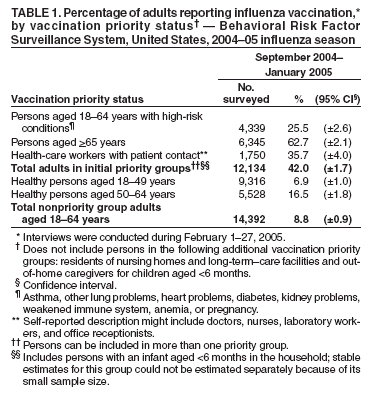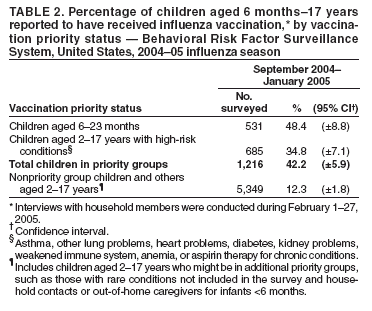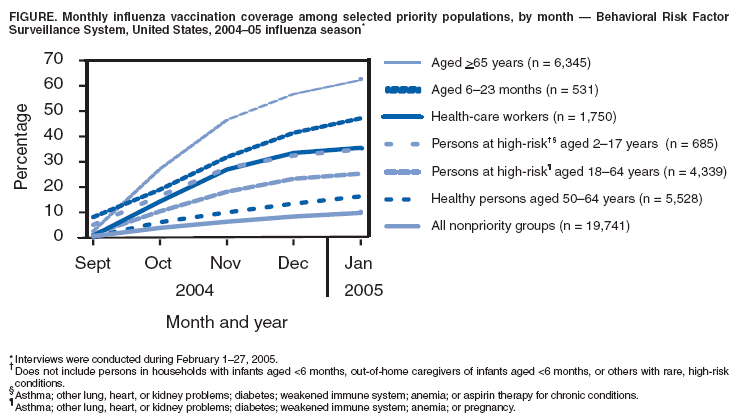 |
|
|
|
|
|
|
| ||||||||||
|
|
|
|
|
|
|
||||
| ||||||||||
|
|
|
|
|
Persons using assistive technology might not be able to fully access information in this file. For assistance, please send e-mail to: mmwrq@cdc.gov. Type 508 Accommodation and the title of the report in the subject line of e-mail. Estimated Influenza Vaccination Coverage Among Adults and Children --- United States, September 1, 2004--January 31, 2005In response to the unexpected shortfall in the 2004--05 influenza vaccine supply, CDC recommended in October 2004 that vaccine be reserved for persons in certain priority groups, including persons aged >65 years and 6--23 months, persons aged 2--64 years with conditions that increased their risk for influenza complications, residents of chronic-care facilities, close contacts of infants aged <6 months, and health-care workers with direct patient contact (1). In late December 2004, based on declining demand among these groups, two additional groups (i.e., healthy persons aged 50--64 years and household contacts of all persons at high risk) were added to the list of vaccination priority groups (2). To monitor influenza vaccination coverage during the 2004--05 season, the Behavioral Risk Factor Surveillance System (BRFSS), an ongoing, state-based, telephone survey of civilian, noninstitutionalized persons, added new questions to collect information on priority status and the month and year of vaccination for adults and children (3). This report is based on analysis of data collected during February 1--27, 2005, regarding respondent-reported receipt of influenza vaccination during September 1, 2004--January 31, 2005. The results of this analysis indicated that influenza vaccination coverage levels through January 2005 among adults in priority groups nearly reached those in recent years, whereas coverage levels among adults not in priority groups were approximately half of levels in 2003, in part because 9.3% of those unvaccinated persons in nonpriority groups declined vaccination this season. The results further suggested that designation of the priority groups successfully directed the nation's influenza vaccine supply to those at highest risk. In addition, vaccination coverage among children aged 6--23 months was notable (48.4%), given that 2004--05 was the first year this group was recommended for influenza vaccination (4). In previous years, BRFSS asked adult respondents whether they had been vaccinated against influenza during the preceding 12 months. No influenza vaccination questions were asked regarding children, and the only questions related to high-risk medical conditions referred to diabetes and asthma. To more closely monitor coverage during this shortfall season, influenza vaccination questions were added during November 2004--February 2005 regarding children, priority group status, and month and year of vaccination. For comparison with the 2004--05 season, data from the 2003 National Health Interview Survey (NHIS) were used. Similar to the BRFSS survey question, NHIS routinely asks adult respondents if they received a "flu shot" during the preceding 12 months; NHIS also collects information on occupations and high-risk medical conditions. NHIS was conducted during 2003 and consisted of in-person interviews; the household response rate was 89.2%. For children, the only previous available national data on influenza vaccine coverage were collected in the 2003 National Immunization Survey (NIS), which reported on vaccination coverage during the 2002--03 season for children aged 6--23 months with an overall response rate among eligible households of 62.7% (5). Because BRFSS data collection is ongoing, final response rates for February were not yet available. Preliminary estimates indicate that the median state-level response rate for February was 51.7% (range: 33.4%--69.8%), based on CASRO guidelines. Analysis was based on 26,868 interviews from 50 states and the District of Columbia. Vaccination Coverage Among AdultsAmong adults, influenza vaccination coverage through January of the 2004--05 season was highest among persons aged >65 years (62.7%), followed by health-care workers with patient contact (35.7%) and those aged 18--64 years with high-risk conditions (25.5%) (Table 1). In comparison, the 2003 NHIS indicated coverage of 65.6% for persons aged >65 years, 40.1% for health-care workers, and 34.2% for adults aged 18--64 years with high-risk conditions. In contrast, influenza vaccination coverage among healthy persons aged 18--64 years who were not health-care workers or contacts of children aged <6 months was lower than in the previous season (8.8% compared with 17.8%) (CDC, unpublished data, 2005). Among the reasons cited by respondents for not receiving vaccination, was "saving vaccine for people who need it more," cited by 9.3% of those who were not in priority groups and were not vaccinated. This represents approximately 17.5 million doses of vaccine potentially made available to persons in priority groups. Vaccination uptake was higher in October and November and tapered off during December and January (Figure). Among the adults in the priority groups established in October, 2% of the vaccinations through January occurred in September, 40% in October, 32% in November, 17% in December, and 9% in January. Vaccination Coverage Among ChildrenInfluenza vaccination coverage (>1 doses) among children aged 6--23 months (48.4%) and among children aged 2--17 years with high-risk conditions (34.8%) was substantially higher than among children not in priority groups (12.3%) (Table 2). Of the vaccinations received through January, 17% occurred in September, 23% in October, 28% in November, 20% in December, and 12% in January (Figure). In comparison, the 2003 NIS data indicated that coverage among children aged 6--23 months for the 2002--03 influenza season, before they were recommended for vaccination by the Advisory Committee on Immunization Practices (ACIP), was 7.4% (5). Reported by: GL Euler, DrPH, CB Bridges, MD, CJ Brown, MS, PJ Lu, PhD, J Singleton, MS, Epidemiology and Surveillance Div; S Stokley, MPH, Immunization Svcs Div; SY Chu, PhD, M McCauley, MTSC, Office of the Director, National Immunization Program; MW Link, PhD, AH Mokdad, PhD, L Elam-Evans, PhD, LS Balluz, ScD, WS Garvin, WP Bartoli, GM Town, MS, M Sussman-Walsh, K O'Neill, D Gilbertz, Div of Adult and Community Health, National Center for Chronic Disease Prevention and Health Promotion, CDC. Editorial Note:During September 1, 2004--January 31, 2005, estimates of influenza vaccination coverage indicate that despite an unexpected and substantial vaccine shortfall, coverage levels among adults in the original influenza vaccine priority groups were similar to historical demand based on the 2003 NHIS (3), thereby suggesting the effectiveness of prioritization. This resulted, in part, from the estimated 17.5 million persons not in priority groups whose primary reported reason for not being vaccinated was to save vaccine for people who needed it more. According to the February 2005 BRFSS, approximately two thirds of the administered vaccine doses through January went to persons in the initial priority groups identified in October whereas, during 2003, only approximately one half of all doses of influenza vaccine were administered to persons in these groups. The provision of >1 doses of influenza vaccination to 48.4% of children aged 6--23 months during this first influenza season following implementation of the ACIP recommendations suggests how quickly physicians and parents can adopt a new disease-prevention guideline (4--6). Because the Chiron vaccine was not licensed for use in children aged <4 years, the supply of influenza vaccine for children aged 6--23 months was not affected by the shortfall. For the first time, a nationwide, state-based surveillance system (i.e., BRFSS) was used to assess influenza vaccination coverage by month of vaccination and provided the capability to report at intervals as brief as 1 week. This surveillance system also provided the first national influenza vaccination coverage estimates for children aged 2--17 years with high-risk conditions. Having national and state population-based estimates of vaccination coverage by month and priority status from early in the influenza season afforded policy makers, health-care providers, public health leaders, and the public timely information to make decisions regarding distribution and usage of the limited supply of vaccine. The findings in this report are subject to at least four limitations. First, BRFSS is a land-line telephone--based survey and excludes those segments of the population without telephones or who use only cellular telephones. Second, data are self-reported and subject to recall bias, particularly for questions that require recall over a longer period; therefore, for certain behaviors, prevalence estimates might be under- or overreported. Third, certain influenza vaccine priority groups were not considered in the survey, including institutionalized adults and adult caretakers of children aged <6 months outside of the home (e.g., child care workers). Finally, these results do not include all of the vaccinations received during the 2004--05 influenza season. However, based on reports of vaccination, estimated 2004--05 coverage appeared to increase by less than one percentage point during February among all the priority and nonpriority groups except those aged 6--23 months, among whom coverage appeared to increase nearly four percentage points, from 48.4% to 52.2%. Comparability of findings from the BRFSS survey with results of the 2003 NHIS is limited because of differences in the survey designs and timeframes. First, the 2003 NHIS is conducted throughout the entire 2003 calendar year. Thus, the results reflect vaccinations received anytime during the entire 2002--03 influenza season and vaccinations received during parts of both the 2001--02 and 2003--04 seasons. Second, the interviews are conducted in person, rather than by telephone. Analysis of 2005 NHIS data, when they become available, will be helpful to further assess the impact of the 2004--05 vaccine shortfall and to provide comparisons with results from the February 2005 BRFSS survey. Vaccination patterns during the 2004--05 influenza season have been affected by several factors. Although an unexpected and substantial reduction of vaccine supply occurred at the beginning of the season, prioritization was quickly recommended and followed. The 2004--05 influenza season was less severe than the 2003--04 season and did not peak until mid-February (7). In addition, this was the first full season following the ACIP recommendation to vaccinate all children aged 6--23 months. Despite the shortfall of inactivated influenza vaccine, the level of coverage achieved among those groups prioritized in 2004--05 appears to be similar to historical coverage. Additional guidelines for prioritization of influenza vaccination in the event of a future influenza vaccine shortfall are in development and should assist with efforts to maximize use of available vaccine. References
Table 1  Return to top. Table 2  Return to top. Figure  Return to top.
Disclaimer All MMWR HTML versions of articles are electronic conversions from ASCII text into HTML. This conversion may have resulted in character translation or format errors in the HTML version. Users should not rely on this HTML document, but are referred to the electronic PDF version and/or the original MMWR paper copy for the official text, figures, and tables. An original paper copy of this issue can be obtained from the Superintendent of Documents, U.S. Government Printing Office (GPO), Washington, DC 20402-9371; telephone: (202) 512-1800. Contact GPO for current prices. **Questions or messages regarding errors in formatting should be addressed to mmwrq@cdc.gov.Page converted: 3/31/2005 |
|||||||||
This page last reviewed 3/31/2005
|